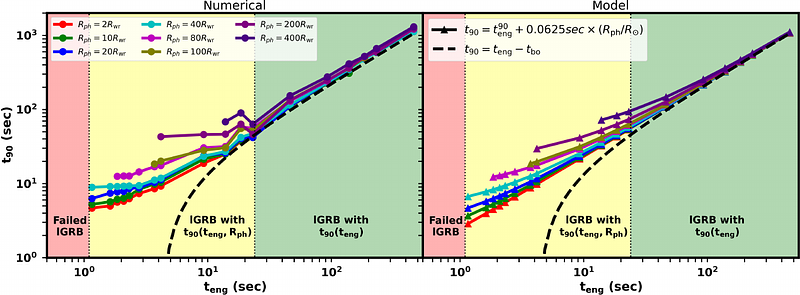A Novel Relationship Between Gamma Ray Burst Duration And Photospheric Radius

A Novel Relationship Between Gamma Ray Burst Duration And Photospheric Radius
Ranadeep Ghosh Dastidar, Paul Duffell
AbstractLong Gamma Ray Bursts (lGRBs) are associated with jets in Type Ic broadline supernovae. The Collapsar model provides a theoretical framework for the jet formation from the core collapse of a massive star in such supernovae. The GRB can only be produced after a successful jet break out from the star. Under this formalism the GRB duration ($t_{\rm{90}}$) has been hypothesized to be the difference between the central engine activity duration ($t_{\rm{eng}}$) and the jet breakout time ($t_{\rm{bo}}$), that is $t_{\rm{90}} = t_{\rm{eng}} - t_{\rm{bo}}$. This disallows $t_{\rm{90}} > t_{\rm{eng}}$ and puts a lower bound on successful lGRB jet central engine duration ($t_{\rm{eng}} > t_{\rm{bo}}$), various numerical simulations have shown otherwise. This study considers a photospheric GRB emission from a relativistic jet punching out of a Wolf-Rayet-like star. We use the bolometric lightcurve generated to calculate the lGRB duration ($t_{\rm{90}}$) for varying engine duration. We find for longer engine duration the lGRB lightcurve reflects the jet profile and $t_{\rm{90}} \approx t_{\rm{eng}}$. While for shorter engine duration, the $t_{\rm{90}}$ has photospheric radius ($R_{\rm{ph}}$) dependence. This can be modeled by a relation, $t_{\rm{90}} = t^{\rm{90}}_{\rm{eng}} + 0.03\left(\frac{R_{\rm{ph}}}{c}\right)$, where c is the speed of light, with a lower bound on $t_{\rm{90}}$ for a successful lGRB. This relation should be most relevant for possible low-luminous lGRBs originating from a collapsar with central engine duration comparable to the jet breakout time.